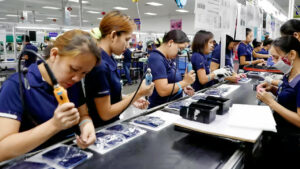THE Department of Trade and Industry (DTI) said industrialization is the path to take in containing the growing trade deficit, which has been preventing the country’s development.
At a budget hearing on Wednesday, Trade Undersecretary and Board of Investments Managing Head Ceferino S. Rodolfo said that the trade deficit grew sharply to $52.59 billion in 2023 from $3.3 billion in 2014.
“That is why we are saying that we have to industrialize our way out of the trade deficit; we cannot just export our way out of the trade deficit because we are really importing a lot of products that we could very well produce,” he added.
“If you look at the primary contributors (to the deficit), these would be automotive, steel, petrochemicals, cement, and, of course, petroleum and rice, which are high on the list, but we cannot do anything about them in the short term,” he said.
According to Mr. Rodolfo, the Philippines needs heavy industry and manufacturing to get on a firm development path.
He said steps have already been taken, noting that steel rebar producer SteelAsia Manufacturing Corp. recently inaugurated a factory in Cebu.
This brings SteelAsia’s rebar capacity to the largest in Southeast Asia, according to Mr. Rodolfo.
“In addition to this, on the topic of integrated steel facilities, we are also looking at a potential foreign investor, (which is) the largest steel-making company in Southeast Asia,” he said.
“We are hoping that they will come; in fact, we are already in advanced stages of discussions with them,” he added.
According to the DTI’s presentation to the House of Representatives, the trading relationships that were the source of the largest deficits were China, Indonesia, South Korea, Thailand, Malaysia, Singapore, Australia, Vietnam, Saudi Arabia, and Taiwan.
The Philippine trade-in-goods deficit widened by 9.3% to $4.3 billion in June, the Philippine Statistics Authority said.
However, the trade deficit in the first six months narrowed 9.5% to $25 billion.
The balance of trade in goods has been in deficit for 109 straight months, or since the $64.95-million surplus posted in May 2015.
Mr. Rodolfo said that despite increasing exports, the trade deficit is still not narrowing due to imports.
“Even if we are the fastest-growing economy in the region, much of the growth is being met by imports,” he said.
He added that the top opportunities for growth are mining and processing of minerals, semiconductors and electronics, information technology and business process management, and non-meat agricultural products.
“Mining currently accounts for less than 1% of gross domestic product; imagine if we could increase that to 1% in the succeeding years, to 2%, 3%, and so on,” he said.
“Second are semiconductors and electronics, particularly because of supply chain issues. We have been getting a lot of attention from other countries on this,” he added. — Justine Irish D. Tabile
